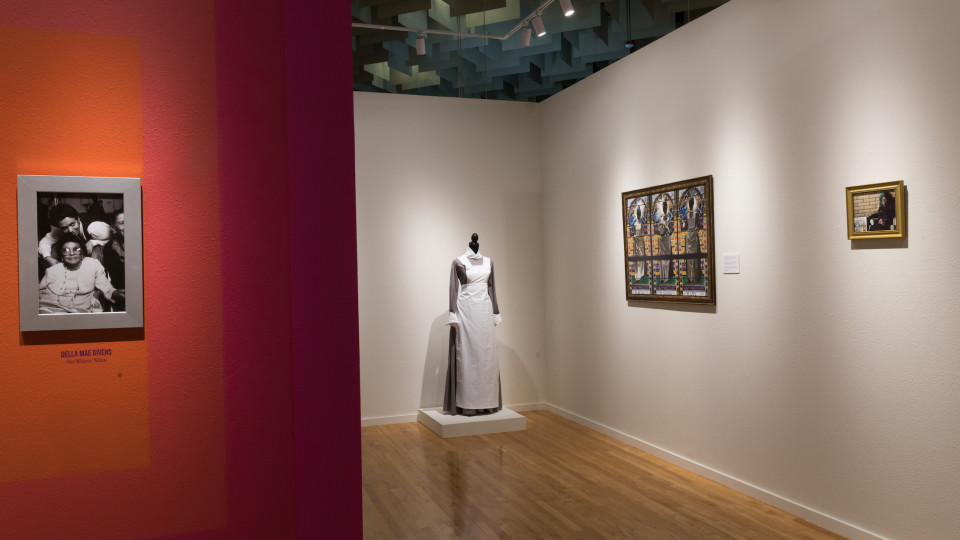Artist Q'shaundra James writes about the dress she created to accompany her digital painting, The Saints: The Mothers of Gynecology. The dress and painting are currently on view in Seeing/Seen.
In order to properly honor the Mothers of Gynecology, I created a uniform indicative of a nineteenth century nurse. This decision not only allowed me to remain historically accurate but also recognize Betsy, Anarcha, and Lucy as respected surgeons who have made great contributions towards the field of gynecology. Rather than focusing on their enslavement and inability to consent to horrific procedures, I am highlighting their extraordinary skills, knowledge, and adaptability which ignited the progress of medical practices dealing with the health of the female reproductive system.
Assembling the main dress consisted of simple lines and inexpensive fabric that served no purpose besides functionality. This minimalist design coupled with a drab color, gray, triggered an unexpected response. As the garment took the shape of the female form—an adoption to the mannequin over which it had been draped—I began to get the eerie feeling of a distressed inhabitant reaching out across time.
Deeply engrossed in the sewing machine, I would catch a peripheral glimpse of the gray shape and automatically be filled with dread and panic. It became a constant job in which my mind had to remind my body not to react. It was just a dress and not a spirit appearing before me to solicit for my help. Even so, the dress represented more than clothing and its evolution through time. The ill fit and silhouette of the dress haunted me. It projected a time in which enslaved Black women were subjected to clothing that wasn’t designed to highlight their beauty or individuality. Subconsciously, the somber dress represented the labor of enduring mistreatment and the title of inferiority. I could contribute this phenomenon to an epigenetic signature passed on to me and all descendants of the African diaspora. Inherited trauma may have left a chemical mark on my genes that consequently affects my level of cortisol, a hormone involved in stress response. On the other hand, maybe Hollywood’s over exploitation of Black trauma has inadvertently nurtured a fear of all things Antebellum. Regardless of the reasons, that heart palpitating reaction encouraged me work faster towards adding the uniform’s additions: cuffs, collar, and apron.
Those three accents transformed the dreary dress and gave it purpose and status. As those distinct features were added, that haunting inhabitant dissolved back into a time I never knew I could access.
Seeing/Seen was photographed by Mikayla Whitmore. Artworks in the photograph, from L - R: Lester Sloan, Della Mae Givens: Paul Williams' Widow, 1995, Black and white photograph; James, The Saints: The Mothers of Gynecology, 2021, Dress and digital painting; Brent Holmes, Ariel Hall: Daughter, musician, sister, college student, 2021, Photograph. The exhibition was curated by Erica Vital-Lazare.
You can find out more about James' work at her website: https://www.qshaundrajames.com

